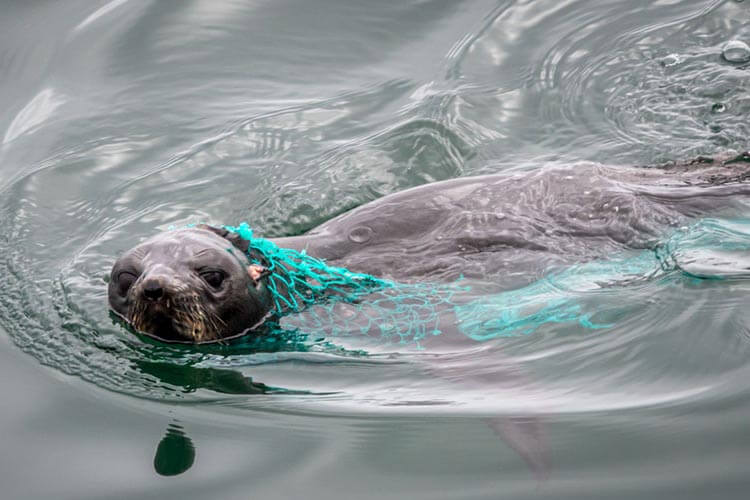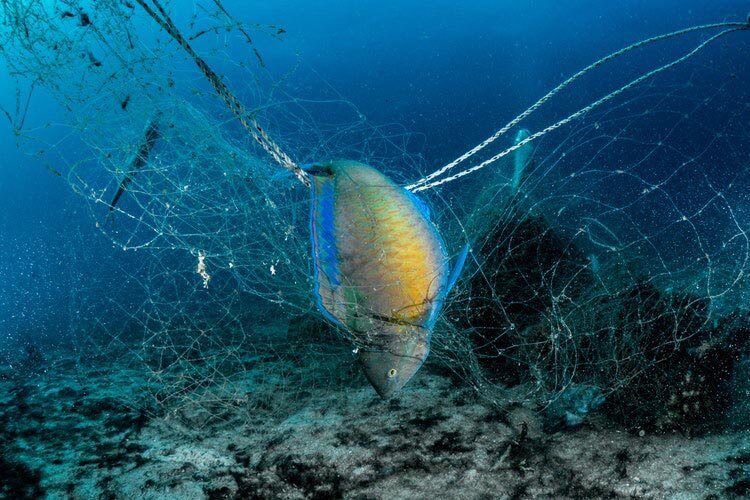
By DIVE Staff
The Ocean Conservancy is calling for better measures to protect the marine environment from abandoned, lost, or discarded fishing gear (ALDFG or ‘ghost gear’) at the United Nations ‘global plastics treaty’ negotiations.
From 29 May to 2 June, the United Nations will be hosting the second formal round of negotiations (INC-2) for an international legally binding instrument (ILBI) on plastic pollution.
Widely known as the ‘global plastics treaty,’ the agreement aims to curb the global plastic pollution crisis, of which the ocean often bears the brunt, but the Ocean Conservancy says that ghost gear – a major source of plastic pollution and the deadliest to ocean wildlife – has been largely absent from the conversation.
As a UN-accredited negotiating organization advocating for policy solutions to ghost gear worldwide through its Global Ghost Gear Initiative, Ocean Conservancy has released a report calling on the United Nations to include strong ghost gear provisions in the agreement.
‘We cannot effectively address ocean plastic pollution without acknowledging the prevalence and impact of ghost gear. It is the elephant seal in the room,’ said Nicholas Mallos, Ocean Conservancy’s Vice President of Conservation, Ocean Plastics. ‘We call on every country involved in negotiations to include strong ghost gear provisions in the plastics treaty.’
Related articles

Historic estimates have suggested that ALDFG makes up 10 per cent of marine litter in the world’s oceans, but recent surveys conducted by the Ocean Conservancy as part of its Global Ghost Gear Initiative (GGGI) put this figure much higher, with fishing gear representing 20 per cent of litter found on beaches in the North-East Atlantic and up to 86 per cent of all floating macroplastics in ocean gyres by weight.
Globally, an estimated 5.7 per cent of fishing nets, 8.6 per cent of traps and pots, and 29 per cent of fishing lines end up lost or abandoned in the marine environment each year. Ocean Conservancy research has found that ghost gear is the single deadliest form of marine debris, and the US National Oceanic and Atmospheric Administration (NOAA) estimates that an up to 30 per cent decline in some fish stocks can be attributed to ghost gear.
Despite this, fishing gear was not mentioned in the treaty resolution adopted by the UN in March 2022. Submissions invited from countries across the globe by the UN Environmental Programme (UNEP) Secretariat also failed to properly address the issue of ghost gear.
Although a small number of nations have implemented regulations for the management of lost or abandoned gear, they are few in number, and no international agreement for the management of ghost gear exists as yet.

In light of the lack of international regulations for ghost gear management, the Ocean Conservancy is calling for nine specific provisions to be considered in the upcoming negotiations:
- Fishers and vessel operators should be required to report lost or abandoned fishing gear under no-fault national reporting schemes.
- Fishing gear marking and loss reporting should be a condition of any authorization to fish.
- Mandates for gear designers, manufacturers and retailers that ensure gear components have built-in traceability where practical and realistically feasible.
- Research and development of gear designed to disable itself after control is lost, such as escape hatches in traps and pots and truly marine biodegradable/compostable materials that will break down into biomass, not petroleum-based microplastic.
- Means for responsible disposal, cleaning and sorting of end-of-life fishing and aquaculture gear, gear found during retrieval projects, and other aquatic litter.
- Requirement of aquaculture operators to establish plans to minimize infrastructure loss due to extreme weather or other events.
- Governments should subsidize courses for training and awareness-building for fishers and vessel operators on best practices to avoid gear loss.
- Businesses should provide an alternate, convenient, less costly means of end-of-life fishing gear disposal to actively incentivize the retrieval of lost nets and their proper disposal.
- Seafood businesses should require their suppliers to conform with best practices.
‘Fishing gear is designed to trap and kill marine life, and since the vast majority of fishing gear is made of plastics, lost gear can continue to do so indefinitely,’ said Joel Baziuk, Associate Director of Ocean Conservancy’s Global Ghost Gear Initiative and a 20-year veteran of the Canadian fishing industry. ‘Ghost gear is not only devastating for our ocean, but for the fishers and communities that depend on it for their livelihoods.’
Additional details and recommendations can be found in the GGGI’s new report, The Impact of Fishing Gear as a Distinct Source of Marine Plastic Pollution.


